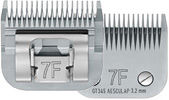What Makes a Great Scissor Sharpener?
- Feb 6, 2019
- 4 min read
Updated: Jul 1
Are your grooming or hairdressing scissors feeling dull, tugging at hair, or no longer giving you a clean cut? Don’t replace them just yet. A great scissor sharpener can restore your bevel edge or hairdressing scissors to peak performance with precision honing, correct tensioning, and the right sharpening technique for your blade type. But with so many sharpening services available, how do you know who to trust? In this article, we’ll break down the top qualities that define a professional scissor sharpener, so you can choose a service that protects your tools and delivers salon-quality results.

The importance of sharp scissors
Scissors are an essential tool in many aspects of dog grooming life, from snipping arounds pads to a full body trim. However, over time, the blades on a scissor can become dull and lose their cutting effectiveness. This can lead to frustration and inefficiency in your tasks. That's where a good scissor sharpener comes in.
A sharp scissor not only makes your scissoring tasks easier and more efficient but also enhances the overall quality of your work. Whether you're a professional working in a salon , or a pet owner pursuing your creative endeavours, having sharp scissors is crucial for achieving precise and clean cuts. Now, let's dive into the qualities that define a good scissor sharpener.
What makes a good scissor sharpener
When it comes to selecting a good scissor sharpener, several factors should be taken into account to ensure you make the right choice. Let's explore some of the top qualities to look for in a good scissor sharpener.
Precision Equipment & Technique
A great scissor sharpener doesn’t just rely on experience—they use the right tools. Look for someone who uses:
Flat hone sharpening systems (ideal for convex edge)
Diamond wheels or fine grinding stones
Polishing tools for mirror-finish edges
Proper alignment and tensioning are also essential. Scissors that are over-tightened or poorly aligned can strain your hands and damage coat or hair.
Compatibility with Different Types of Scissors
Before choosing a sharpener, it’s important to understand the type of scissors you use.
Bevel edge scissors are commonly found in dog grooming and student kits. They have a slightly angled edge and require a specific sharpening approach.
Convex edge scissors, often used in hairdressing, are finely honed and require a high degree of skill and the correct polishing equipment.
A good sharpener should understand the difference and tailor their technique accordingly.
Cleanliness & Care
A great sharpening service involves more than just the edge. The best sharpeners will:
Disassemble scissors
Replace any micro-serration
Clean hinges and blades
Remove rust or buildup
Reassemble and test for smooth action
Attention to detail in cleaning often reflects the overall quality of the sharpening.

What to look for when you need a scissor sharpener
All scissors should be regularly maintained if you have experienced the following - The scissor pushes the hair - The scissor pulls the hair - The scissor is dropped - The scissor stop is missing - The scissor catches at the tip - The tension nut or screw won’t stay tight
Dog scissors come in all shapes and sizes with two different edges - Bevel and Convex. Bevel edge scissors are made from hardened steel and has a squared off bevel blade that tend to have micro serrations, to help hold the coat, ideal for dog grooming students. Whereby the convex edge is more smoother, like the shell of a clam, curved into a convex shape providing a crisp cutting feel for more educated dog groomers.

Scissors must be cleaned and oiled daily. Even after coats have been dried, hair will still hold moisture, which in turn will work into your scissor and the centre screw that holds the scissor together. When you have finished, spray the scissors with Clipit Ice Care Spray for sanitising and helping to prevent contamination. Wipe dry and then apply Clipit Easy Oil Spray into the centre screw. Open and close a few times, wipe off the excess and then store into its holster.
By cleaning and oiling your scissors regularly you will play the part of making sure they last longer. The sharpener only produces the new edge.
Reviews and recommendations from other users
One of the best ways to gauge the quality of a scissor sharpener is by reading reviews and recommendations from other users. Take the time to research and read customer reviews, both positive and negative, to get a better understanding of the sharpener's performance and reliability.
Look for sharpener models that have consistently positive reviews and high ratings. Pay attention to the specific features or qualities that users appreciate, as these can give you insights into what to expect from the sharpener. On the other hand, be cautious of sharpener models with multiple negative reviews or complaints about durability or performance issues.
Additionally, consider seeking recommendations from friends, family, or colleagues who have experience with scissor sharpeners. They may be able to provide valuable insights and recommendations based on their own usage and satisfaction.
Conclusion:
Choosing the right scissor sharpener can extend the life of your tools, improve your cutting performance, and even prevent repetitive strain injuries. Whether you use bevel edge grooming scissors or high-end convex edge hairdressing shears, make sure your sharpener understands the tools of your trade.
Ready to restore your scissors? Book your sharpening with Clipit now →








Comments